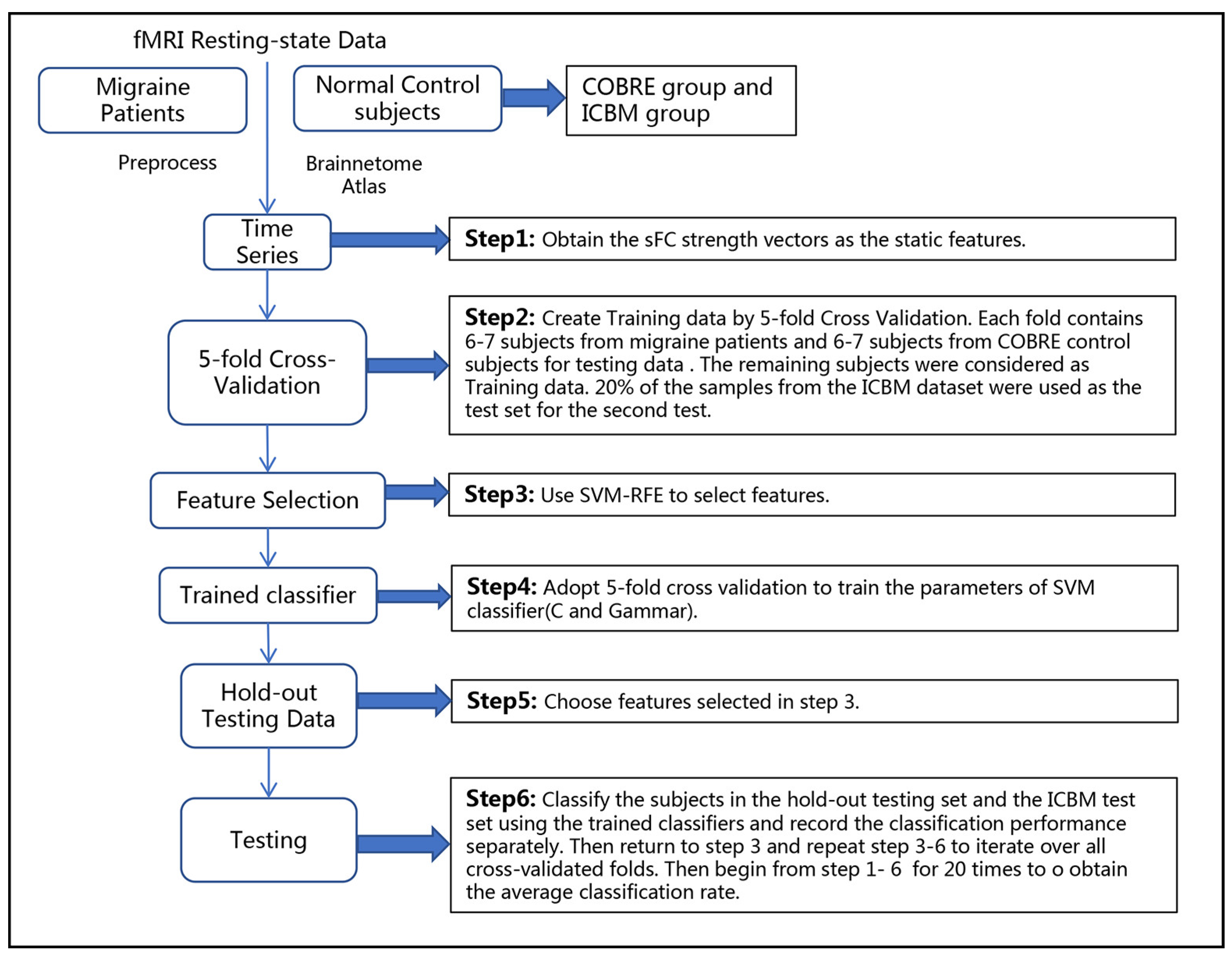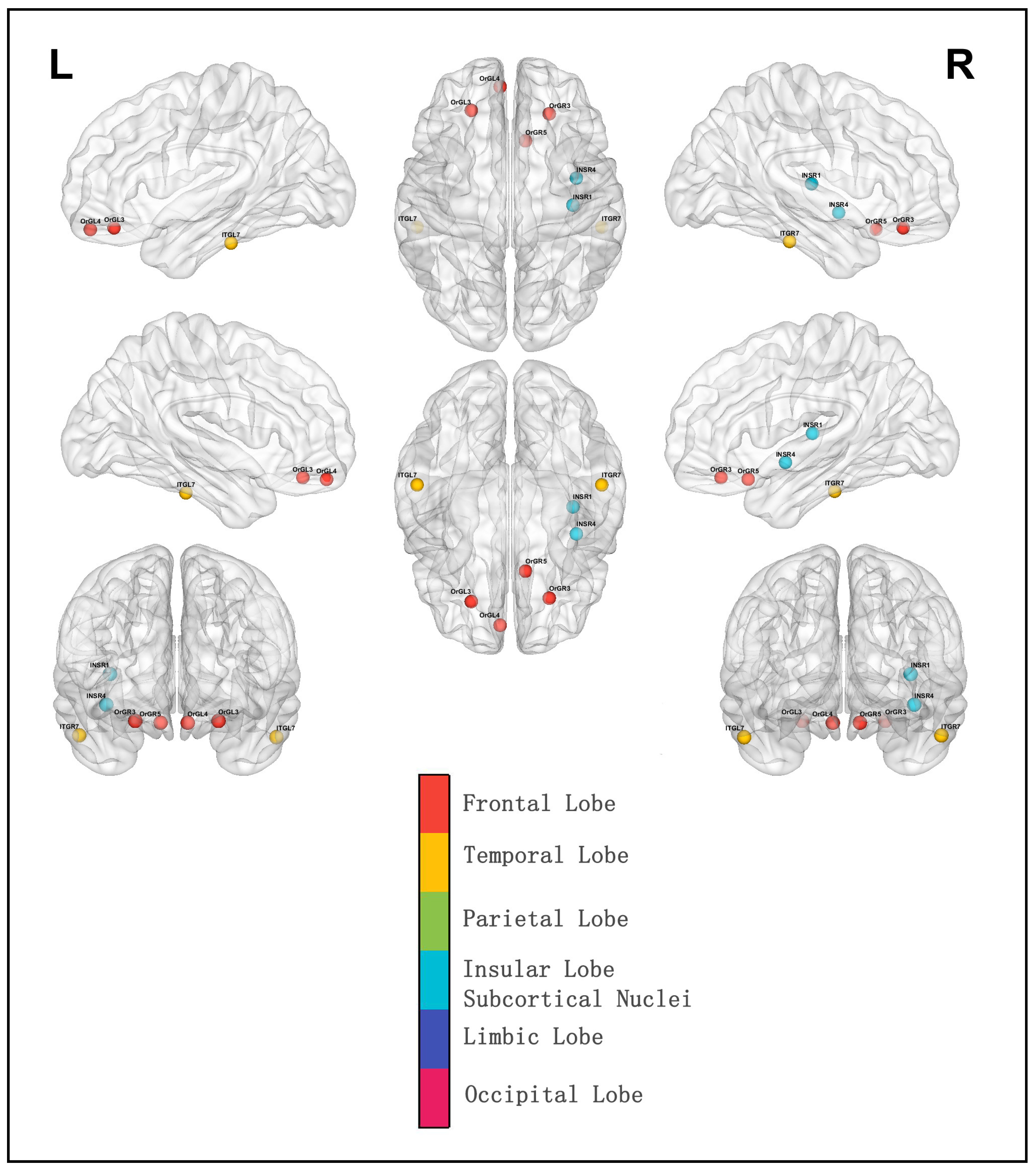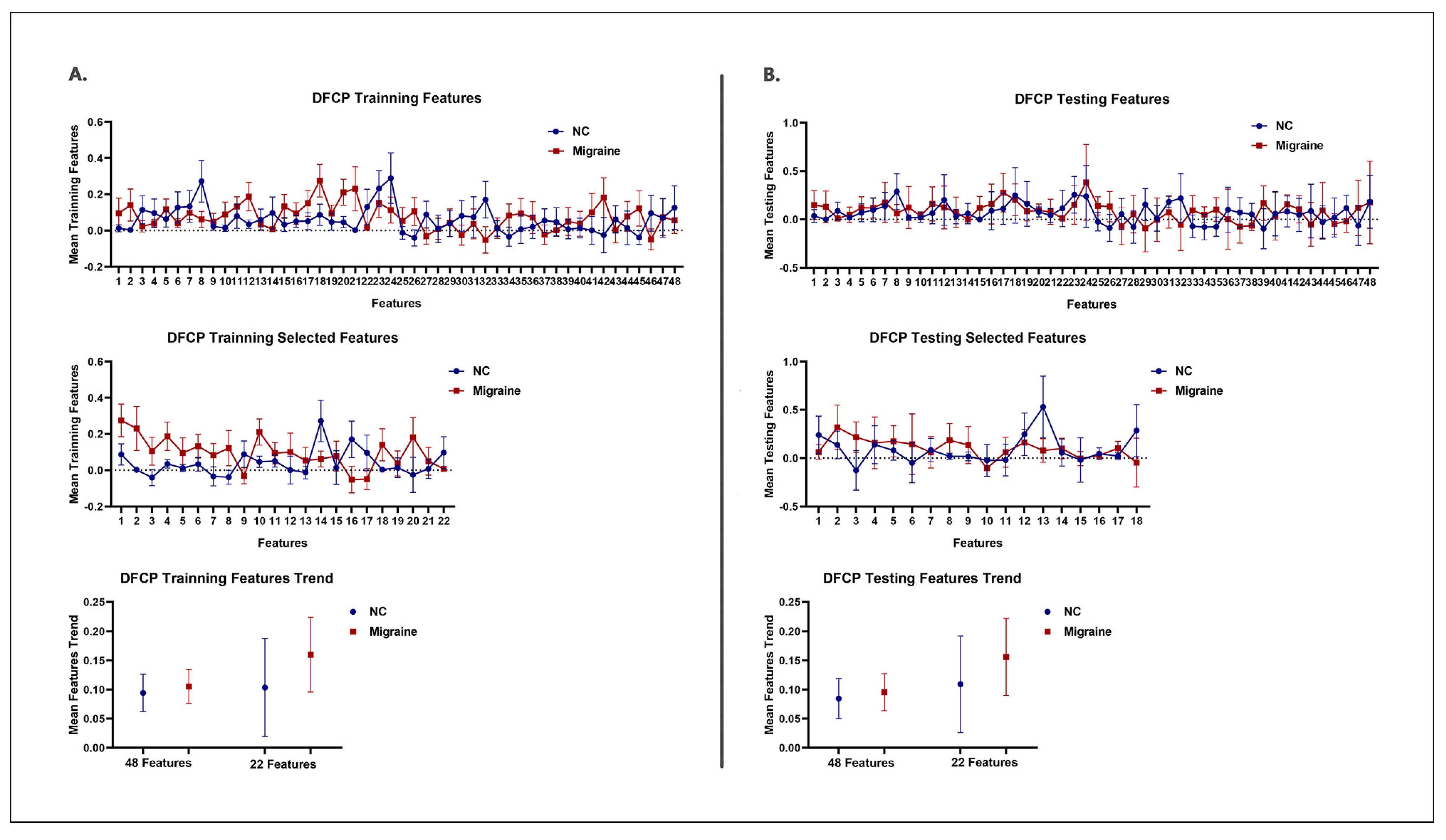Classification of Migraine Using Static Functional Connectivity Strength and Dynamic Functional Connectome Patterns: A Resting-State fMRI Study
Abstract
1. Introduction
2. Materials and Methods
2.1. Data Acquisition
2.2. Data Preprocessing
2.3. Static Function Connectivity(sFC) Strength
2.4. Dynamic Functional Connectivity Strength
2.5. Automatic Generation of WQCPs
2.6. Classification Framework
2.6.1. Static Functional Connectivity(sFC) Strength Approach
| Algorithm 1: classification based on sFC strength features |
|
2.6.2. Dynamic Functional Connectome Pattern (DFCP)Approach
| Algorithm 2: classification based on DFCPs features |
|
2.6.3. Combined sFC Strength and DFCP Approach
| Algorithm 3: classification based on combined the sFC strength and DFCPs features |
|
2.7. sFC Strength Features
2.8. DFCP Features
3. Results
3.1. Subsection
3.2. sFC Strength Features Estimation
3.3. DFCP Features Estimation
4. Discussion
4.1. Classification Performance
4.2. Time Window Length of DFCPs
4.3. sFC Strength Features
4.4. DFCP Strength Features
4.5. Limitations and Future Directions
5. Conclusions
Supplementary Materials
Author Contributions
Funding
Institutional Review Board Statement
Informed Consent Statement
Data Availability Statement
Conflicts of Interest
References
- Schwedt, T.J.; Chiang, C.-C.; Chong, C.D.; Dodick, D.W. Functional MRI of migraine. Lancet Neurol. 2015, 14, 81–91. [Google Scholar] [CrossRef] [PubMed]
- Headache Classification Committee of the International Headache Society (IHS) The international classification of headache disorders, 3rd edition. Cephalalgia 2018, 38, 1–211. [CrossRef] [PubMed]
- Lipton, R.B.; Bigal, M.E.; Diamond, M.; Freitag, F.; Reed, M.L.; Stewart, W.F. Migraine prevalence, disease burden, and the need for preventive therapy. Neurology 2007, 68, 343–349. [Google Scholar] [CrossRef] [PubMed]
- WHO. Global Health Estimates: Life Expectancy and Leading Causes of Death and Disability. Available online: https://www.who.int/data/gho/data/themes/mortality-and-global-health-estimates (accessed on 5 July 2021).
- Schwedt, T.J.; Chong, C.D.; Wu, T.; Gaw, N.; Fu, Y.; Li, J. Accurate classification of chronic migraine via brain magnetic resonance imaging. Headache J. Head Face Pain 2015, 55, 762–777. [Google Scholar] [CrossRef]
- Lu, W.; Dong, K.; Cui, D.; Jiao, Q.; Qiu, J. Quality assurance of human functional magnetic resonance imaging: A literature review. Quant. Imaging Med. Surg. 2019, 9, 1147. [Google Scholar] [CrossRef] [PubMed]
- Zhang, Q.; Wu, Q.; Zhang, J.; He, L.; Huang, J.; Zhang, J.; Huang, H.; Gong, Q. Discriminative analysis of migraine without aura: Using functional and structural MRI with a multi-feature classification approach. PLoS ONE 2016, 11, e0163875. [Google Scholar] [CrossRef]
- Chong, C.D.; Gaw, N.; Fu, Y.; Li, J.; Wu, T.; Schwedt, T.J. Migraine classification using magnetic resonance imaging resting-state functional connectivity data. Cephalalgia 2017, 37, 828–844. [Google Scholar] [CrossRef]
- Schwedt, T.J.; Si, B.; Li, J.; Wu, T.; Chong, C.D. Migraine subclassification via a data-driven automated approach using multimodality factor mixture modeling of brain structure measurements. Headache J. Head Face Pain 2017, 57, 1051–1064. [Google Scholar] [CrossRef]
- Tu, Y.; Zeng, F.; Lan, L.; Li, Z.; Maleki, N.; Liu, B.; Chen, J.; Wang, C.; Park, J.; Lang, C.N. An fMRI-based neural marker for migraine without aura. Neurology 2020, 94, e741–e751. [Google Scholar] [CrossRef]
- Li, X.L.; Fang, Y.N.; Gao, Q.C.; Lin, E.J.; Hu, S.H.; Ren, L.; Ding, M.H.; Luo, B.N. A diffusion tensor magnetic resonance imaging study of corpus callosum from adult patients with migraine complicated with depressive/anxious disorder. Headache J. Head Face Pain 2011, 51, 237–245. [Google Scholar] [CrossRef]
- Rocca, M.; Pagani, E.; Colombo, B.; Tortorella, P.; Falini, A.; Comi, G.; Filippi, M. Selective diffusion changes of the visual pathways in patients with migraine: A 3-T tractography study. Cephalalgia 2008, 28, 1061–1068. [Google Scholar] [CrossRef] [PubMed]
- Chong, C.D.; Peplinski, J.; Berisha, V.; Ross, K.; Schwedt, T.J. Differences in fibertract profiles between patients with migraine and those with persistent post-traumatic headache. Cephalalgia 2019, 39, 1121–1133. [Google Scholar] [CrossRef] [PubMed]
- Marciszewski, K.K.; Meylakh, N.; Di Pietro, F.; Macefield, V.G.; Macey, P.M.; Henderson, L.A. Fluctuating regional brainstem diffusion imaging measures of microstructure across the migraine cycle. eNeuro 2019, 6, 1–11. [Google Scholar] [CrossRef] [PubMed]
- Rahimi, R.; Dolatshahi, M.; Abbasi-Feijani, F.; Momtazmanesh, S.; Cattarinussi, G.; Aarabi, M.H.; Pini, L. Microstructural white matter alterations associated with migraine headaches: A systematic review of diffusion tensor imaging studies. Brain Imaging Behav. 2022, 16, 2375–2401. [Google Scholar] [CrossRef] [PubMed]
- Onton, J.; Makeig, S. Information-based modeling of event-related brain dynamics. Prog. Brain Res. 2006, 159, 99–120. [Google Scholar] [CrossRef]
- Rashid, B.; Arbabshirani, M.R.; Damaraju, E.; Cetin, M.S.; Miller, R.; Pearlson, G.D.; Calhoun, V.D. Classification of schizophrenia and bipolar patients using static and dynamic resting-state fMRI brain connectivity. Neuroimage 2016, 134, 645–657. [Google Scholar] [CrossRef]
- Chang, C.; Glover, G.H. Time–frequency dynamics of resting-state brain connectivity measured with fMRI. Neuroimage 2010, 50, 81–98. [Google Scholar] [CrossRef]
- Calhoun, V.D.; Miller, R.; Pearlson, G.; Adalı, T. The chronnectome: Time-varying connectivity networks as the next frontier in fMRI data discovery. Neuron 2014, 84, 262–274. [Google Scholar] [CrossRef]
- Zou, Y.; Tang, W.; Qiao, X.; Li, J. Aberrant modulations of static functional connectivity and dynamic functional network connectivity in chronic migraine. Quant. Imaging Med. Surg. 2021, 11, 2253. [Google Scholar] [CrossRef]
- Tu, Y.; Fu, Z.; Zeng, F.; Maleki, N.; Lan, L.; Li, Z.; Park, J.; Wilson, G.; Gao, Y.; Liu, M. Abnormal thalamocortical network dynamics in migraine. Neurology 2019, 92, e2706–e2716. [Google Scholar] [CrossRef]
- Lee, M.J.; Park, B.-Y.; Cho, S.; Park, H.; Kim, S.-T.; Chung, C.-S. Dynamic functional connectivity of the migraine brain: A resting-state functional magnetic resonance imaging study. Pain 2019, 160, 2776–2786. [Google Scholar] [CrossRef] [PubMed]
- Dumkrieger, G.; Chong, C.D.; Ross, K.; Berisha, V.; Schwedt, T.J. Static and dynamic functional connectivity differences between migraine and persistent post-traumatic headache: A resting-state magnetic resonance imaging study. Cephalalgia 2019, 39, 1366–1381. [Google Scholar] [CrossRef] [PubMed]
- Shi, Y.; Zeng, W.; Nie, W.; Yang, J. Multi-channel hierarchy functional integration analysis between large-scale brain networks for migraine: An fMRI study. NeuroImage Clin. 2020, 28, 102462. [Google Scholar] [CrossRef]
- Yan, C.; Zang, Y. DPARSF: A MATLAB toolbox for “pipeline” data analysis of resting-state fMRI. Front. Syst. Neurosci. 2010, 4, 13. [Google Scholar] [CrossRef] [PubMed]
- Fan, L.; Li, H.; Zhuo, J.; Zhang, Y.; Wang, J.; Chen, L.; Yang, Z.; Chu, C.; Xie, S.; Laird, A.R. The human brainnetome atlas: A new brain atlas based on connectional architecture. Cereb. Cortex 2016, 26, 3508–3526. [Google Scholar] [CrossRef] [PubMed]
- Allen, E.A.; Damaraju, E.; Plis, S.M.; Erhardt, E.B.; Eichele, T.; Calhoun, V.D. Tracking whole-brain connectivity dynamics in the resting state. Cereb. Cortex 2014, 24, 663–676. [Google Scholar] [CrossRef]
- Nie, W.; Zeng, W.; Yang, J.; Shi, Y.; Zhao, L.; Li, Y.; Chen, D.; Deng, J.; Wang, N. Extraction and analysis of dynamic functional connectome patterns in migraine sufferers: A resting-state fMRI study. Comput. Math. Methods Med. 2021, 2021, 6614520. [Google Scholar] [CrossRef]
- Li, X.; Zhu, D.; Jiang, X.; Jin, C.; Zhang, X.; Guo, L.; Zhang, J.; Hu, X.; Li, L.; Liu, T. Dynamic functional connectomics signatures for characterization and differentiation of PTSD patients. Hum. Brain Mapp. 2014, 35, 1761–1778. [Google Scholar] [CrossRef]
- Wang, N.; Zeng, W.; Shi, Y.; Yan, H. Brain functional plasticity driven by career experience: A resting-state fMRI study of the seafarer. Front. Psychol. 2017, 8, 1786. [Google Scholar] [CrossRef]
- Guyon, I.; Weston, J.; Barnhill, S.; Vapnik, V. Gene selection for cancer classification using support vector machines. Mach. Learn. 2002, 46, 389–422. [Google Scholar] [CrossRef]
- Hutchison, R.M.; Womelsdorf, T.; Allen, E.A.; Bandettini, P.A.; Calhoun, V.D.; Corbetta, M.; Della Penna, S.; Duyn, J.H.; Glover, G.H.; Gonzalez-Castillo, J. Dynamic functional connectivity: Promise, issues, and interpretations. Neuroimage 2013, 80, 360–378. [Google Scholar] [CrossRef] [PubMed]
- Sakoğlu, Ü.; Pearlson, G.D.; Kiehl, K.A.; Wang, Y.M.; Michael, A.M.; Calhoun, V.D. A method for evaluating dynamic functional network connectivity and task-modulation: Application to schizophrenia. Magn. Reson. Mater. Phys. Biol. Med. 2010, 23, 351–366. [Google Scholar] [CrossRef] [PubMed]
- Peyron, R.; Frot, M.; Schneider, F.; Garcia-Larrea, L.; Mertens, P.; Barral, F.-G.; Sindou, M.; Laurent, B.; Mauguière, F. Role of operculoinsular cortices in human pain processing: Converging evidence from PET, fMRI, dipole modeling, and intracerebral recordings of evoked potentials. Neuroimage 2002, 17, 1336–1346. [Google Scholar] [CrossRef] [PubMed]
- Treede, R.-D.; Kenshalo, D.R.; Gracely, R.H.; Jones, A.K. The cortical representation of pain. Pain 1999, 79, 105–111. [Google Scholar] [CrossRef] [PubMed]
- Verne, G.N.; Robinson, M.E.; Price, D.D. Representations of pain in the brain. Curr. Rheumatol. Rep. 2004, 6, 261–265. [Google Scholar] [CrossRef]
- Mouraux, A.; Diukova, A.; Lee, M.C.; Wise, R.G.; Iannetti, G.D. A multisensory investigation of the functional significance of the “pain matrix”. Neuroimage 2011, 54, 2237–2249. [Google Scholar] [CrossRef] [PubMed]
- Tracey, I. Nociceptive processing in the human brain. Curr. Opin. Neurobiol. 2005, 15, 478–487. [Google Scholar] [CrossRef]
- Schmitz, N.; Arkink, E.B.; Mulder, M.; Rubia, K.; Admiraal-Behloul, F.; Schoonmann, G.G.; Kruit, M.C.; Ferrari, M.D.; van Buchem, M.A. Frontal lobe structure and executive function in migraine patients. Neurosci. Lett. 2008, 440, 92–96. [Google Scholar] [CrossRef]






| Approach | Time Window | Accuracy Std Mean with 95% CI | Precision Std Mean with 95% CI | Recall Std Mean with 95% CI | Specificity Std Mean with 95% CI | F1 Std Mean with 95% CI |
|---|---|---|---|---|---|---|
| sFC Strength | Static | 0.8653 0.0853 [0.8486 0.8821] | 0.8726 0.0974 [0.8535 0.8917] | 0.8686 0.1372 [0.8417 0.8955] | 0.8633 0.1107 [0.8416 0.8850] | 0.8628 0.0931 [0.8461 0.8795] |
| DFCP | 12 s | 0.9382 0.0769 [0.9231 0.9533] | 0.9381 0.0955 [0.9194 0.9568] | 0.9495 0.0866 [0.9325 0.9665] | 0.9264 0.1197 [0.9030 0.9499] | 0.9397 0.0724 [0.9246 0.9547] |
| 24 s | 0.9552 0.0527 [0.9449 0.9655] | 0.9420 0.0796 [0.9264 0.9576] | 0.9790 0.0523 [0.9688 0.9893] | 0.9314 0.0983 [0.9122 0.9507] | 0.9575 0.0490 [0.9471 0.9678] | |
| 36 s | 0.9311 0.0768 [0.9161 0.9462] | 0.9204 0.1001 [0.9008 0.9401] | 0.9562 0.0931 [0.9379 0.9744] | 0.9076 0.1198 [0.8841 0.9311] | 0.9329 0.0765 [0.9179 0.9480] | |
| 48 s | 0.9039 0.0751 [0.8892 0.9186] | 0.8877 0.1016 [0.8678 0.9076] | 0.9426 0.0704 [0.9245 0.9607] | 0.8650 0.0924 [0.8389 0.8911] | 0.9085 0.1330 [0.8938 0.9232] | |
| 60 s | 0.8904 0.0867 [0.8734 0.9074] | 0.8827 0.1137 [0.8604 0.9050] | 0.9210 0.1058 [0.9002 0.9417] | 0.8595 0.1517 [0.8298 0.8893] | 0.8946 0.0831 [0.8776 0.9116] | |
| sFC Strength + DFCP | 12 s | 0.9583 0.0620 [0.9461 0.9704] | 0.9520 0.0818 [0.9360 0.9681] | 0.9724 0.0732 [0.9580 0.9867] | 0.9450 0.0955 [0.9263 0.9637] | 0.9592 0.0619 [0.9471 0.9714] |
| 24 s | 0.9681 0.0467 [0.9590 0.9773] | 0.9541 0.0726 [0.9399 0.9684] | 0.9914 0.0397 [0.9837 0.9992] | 0.9450 0.0895 [0.9275 0.9625] | 0.9703 0.0431 [0.9612 0.9795] | |
| 36 s | 0.9487 0.0604 [0.9368 0.9605] | 0.9281 0.0876 [0.9110 0.9453] | 0.9836 0.0471 [0.9743 0.9928] | 0.9129 0.1101 [0.8913 0.9344] | 0.9525 0.0551 [0.9406 0.9643] | |
| 48 s | 0.9210 0.0745 [0.9064 0.9356] | 0.9006 0.1015 [0.8807 0.9205] | 0.9621 0.0813 [0.9462 0.9781] | 0.8802 0.1292 [0.8549 0.9056] | 0.9255 0.0702 [0.9109 0.9401] | |
| 60 s | 0.9128 0.0889 [0.8954 0.9303] | 0.9017 0.1152 [0.8791 0.9243] | 0.9452 0.0930 [0.9270 0.9635] | 0.8821 0.1471 [0.8533 0.9110] | 0.9170 0.0826 [0.8996 0.9344] |
| Time Window | Approach | Accuracy | Precision | Recall | Specificity | F1 |
|---|---|---|---|---|---|---|
| 12 s | sFC Strength vs. DFCP | 6.7688 × 10−8 (*) | 3.9109 × 10−6 (*) | 1.0474 × 10−5 (*) | 8.9016 × 10−5 (*) | 4.3069 × 10−8 (*) |
| sFC Strength vs. sFC Strength + DFCP | 1.2212 × 10−15 (*) | 3.8783 × 10−10 (*) | 5.7846 × 10−10 (*) | 1.0144 × 10−8 (*) | 6.2172 × 10−15 (*) | |
| DFCP vs. sFC Strength + DFCP | 0.0451 (*) | 0.2502 | 0.0512 | 0.2120 | 0.0442 (*) | |
| 24 s | sFC Strength vs. DFCP | 6.4948 × 10−14 (*) | 3.0128 × 10−7 (*) | 4.5752 × 10−11 (*) | 1.1576 × 10−5 (*) | 5.5733 × 10−14 (*) |
| sFC Strength vs. sFC Strength + DFCP | 0 (*) | 5.2878 × 10−10 (*) | 2.4203 × 10−14 (*) | 8.3851 × 10−8 (*) | 0 (*) | |
| DFCP vs. sFC Strength + DFCP | 0.0839 | 0.2831 | 0.0373 (*) | 0.3260 | 0.0642 | |
| 36 s | sFC Strength vs. DFCP | 4.7401 × 10−8 (*) | 0.0012 (*) | 1.1628 × 10−6 (*) | 0.0109 (*) | 3.3973 × 10−8 (*) |
| sFC Strength vs. Strength + DFCP | 9.4036 × 10−14 (*) | 3.3847 × 10−5 (*) | 9.1094 × 10−13 (*) | 0.0020 (*) | 1.4877 × 10−14 (*) | |
| DFCP vs. Strength + DFCP | 0.0801 | 0.5772 | 0.0049 (*) | 0.7554 | 0.0414(*) | |
| 48 s | sFC Strength vs. DFCP | 0.0011 (*) | 0.2599 | 2.5415 × 10−5 (*) | 0.9190 | 2.3344 × 10−4 (*) |
| sFC Strength vs. Strength + DFCP | 1.9914E-07 (*) | 0.0401 (*) | 3.6740 × 10−8 (*) | 0.2904 | 2.5007 × 10−8 (*) | |
| DFCP vs. Strength + DFCP | 0.1000 | 0.3475 | 0.1220 | 0.3798 | 0.0853 | |
| 60 s | sFC Strength vs. DFCP | 0.0386 (*) | 0.4697 | 0.0040 (*) | 0.8317 | 0.0126(*) |
| sFC Strength vs. sFC Strength + DFCP | 5.4790 × 10−5 (*) | 0.0430 (*) | 2.4769 × 10−6 (*) | 0.2768 | 7.4323 × 10−68 (*) | |
| DFCP vs. Strength + DFCP | 0.0781 | 0.2727 | 0.0812 | 0.3206 | 0.0586 |
| ROI Number | Abbreviation | Anatomic and Modified Cytoarchitectonic Description |
|---|---|---|
| 45 | ORGL3 | Brodmann area 11 (lateral area 11) in orbital gyrus of frontal lobe |
| 46 | ORGR3 | Brodmann area 11 (lateral area 11) in orbital gyrus of frontal lobe |
| 47 | ORGL4 | Brodmann area 11 (medial area 11) in orbital gyrus of frontal lobe |
| 50 | ORGR5 | Brodmann area 13 in orbital gyrus of frontal lobe |
| 101 | ITGL7 | Brodmann area 20 (caudoventral of area 20) in inferior temporal gyrus of temporal lobe |
| 102 | ITGR7 | Brodmann area 20 (caudoventral of area 20) in inferior temporal gyrus of temporal lobe |
| 164 | INSR1 | hypergranular insula in insular gyrus of insular lobe |
| 170 | INSR4 | ventral dysgranular and granular insula in insular gyrus of insular lobe |
| Approach | Accuracy | Precision | Recall | Specificity | F1 |
|---|---|---|---|---|---|
| DFCP | −0.8845 | −0.9412 | −0.7011 | −0.9349 | −0.8773 |
| sFC Strength + DFCP | −0.9136 | −0.9383 | −0.7280 | −0.9438 | −0.8997 |
Disclaimer/Publisher’s Note: The statements, opinions and data contained in all publications are solely those of the individual author(s) and contributor(s) and not of MDPI and/or the editor(s). MDPI and/or the editor(s) disclaim responsibility for any injury to people or property resulting from any ideas, methods, instructions or products referred to in the content. |
© 2023 by the authors. Licensee MDPI, Basel, Switzerland. This article is an open access article distributed under the terms and conditions of the Creative Commons Attribution (CC BY) license (https://creativecommons.org/licenses/by/4.0/).
Share and Cite
Nie, W.; Zeng, W.; Yang, J.; Zhao, L.; Shi, Y. Classification of Migraine Using Static Functional Connectivity Strength and Dynamic Functional Connectome Patterns: A Resting-State fMRI Study. Brain Sci. 2023, 13, 596. https://doi.org/10.3390/brainsci13040596
Nie W, Zeng W, Yang J, Zhao L, Shi Y. Classification of Migraine Using Static Functional Connectivity Strength and Dynamic Functional Connectome Patterns: A Resting-State fMRI Study. Brain Sciences. 2023; 13(4):596. https://doi.org/10.3390/brainsci13040596
Chicago/Turabian StyleNie, Weifang, Weiming Zeng, Jiajun Yang, Le Zhao, and Yuhu Shi. 2023. "Classification of Migraine Using Static Functional Connectivity Strength and Dynamic Functional Connectome Patterns: A Resting-State fMRI Study" Brain Sciences 13, no. 4: 596. https://doi.org/10.3390/brainsci13040596
APA StyleNie, W., Zeng, W., Yang, J., Zhao, L., & Shi, Y. (2023). Classification of Migraine Using Static Functional Connectivity Strength and Dynamic Functional Connectome Patterns: A Resting-State fMRI Study. Brain Sciences, 13(4), 596. https://doi.org/10.3390/brainsci13040596





